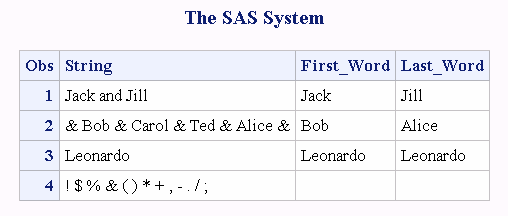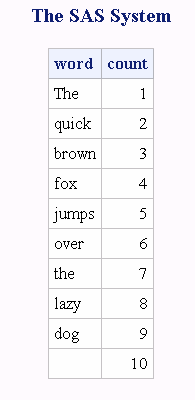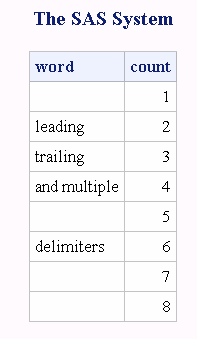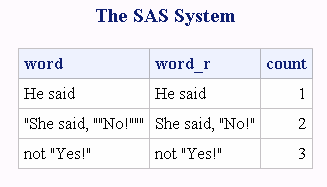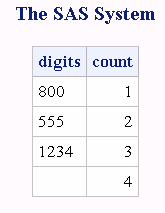SCAN Function
Returns the nth word from a character string.
| Category: | Character |
| Restriction: | I18N Level 0 functions are designed for use with Single Byte Character Sets (SBCS) only. |
| Tip: | The DBCS equivalent function is The DBCS equivalent function is KSCAN. |
Syntax
Required Arguments
string
specifies a character constant, variable, or expression.
count
is a nonzero numeric constant, variable, or expression that has an integer value that specifies the number of the word in the character string that you want SCAN to select. For example, a value of 1 indicates the first word, a value of 2 indicates the second word, and so on. The following rules apply:
Optional Arguments
charlist
specifies an optional character expression that initializes a list of characters. This list determines which characters are used as the delimiters that separate words. The following rules apply:
| Tip | You can add more characters to charlist by using other modifiers. |
modifier
specifies a character constant, a variable, or an expression in which each non-blank character modifies the action of the SCAN function. Blanks are ignored. You can use the following characters as modifiers:
| a or A | adds alphabetic characters to the list of characters. |
| b or B | scans backward from right to left instead of from left to right, regardless of the sign of the count argument. |
| c or C | adds control characters to the list of characters. |
| d or D | adds digits to the list of characters. |
| f or F | adds an underscore and English letters (that is, valid first characters in a SAS variable name using VALIDVARNAME=V7) to the list of characters. |
| g or G | adds graphic characters to the list of characters. Graphic characters are characters that, when printed, produce an image on paper. |
| h or H | adds a horizontal tab to the list of characters. |
| i or I | ignores the case of the characters. |
| k or K | causes all characters that are not in the list of characters to be treated as delimiters. That is, if K is specified, then characters that are in the list of characters are kept in the returned value rather than being omitted because they are delimiters. If K is not specified, then all characters that are in the list of characters are treated as delimiters. |
| l or L | adds lowercase letters to the list of characters. |
| m or M | specifies that multiple consecutive delimiters, and delimiters at the beginning or end of the string argument, refer to words that have a length of zero. If the M modifier is not specified, then multiple consecutive delimiters are treated as one delimiter, and delimiters at the beginning or end of the string argument are ignored. |
| n or N | adds digits, an underscore, and English letters (that is, the characters that can appear in a SAS variable name using VALIDVARNAME=V7) to the list of characters. |
| o or O | processes the charlist and modifier arguments only once, rather than every time the SCAN function is called. Using the O modifier in the DATA step (excluding WHERE clauses), or in the SQL procedure can make SCAN run faster when you call it in a loop where the charlist and modifier arguments do not change. The O modifier applies separately to each instance of the SCAN function in your SAS code, and does not cause all instances of the SCAN function to use the same delimiters and modifiers. |
| p or P | adds punctuation marks to the list of characters. |
| q or Q | ignores delimiters that are inside of substrings that are enclosed in quotation marks. If the value of the string argument contains unmatched quotation marks, then scanning from left to right will produce different words than scanning from right to left. |
| r or R | removes leading and trailing blanks from the word that SCAN returns.If you specify both the Q and R modifiers, then the SCAN function first removes leading and trailing blanks from the word. Then, if the word begins with a quotation mark, SCAN also removes one layer of quotation marks from the word. |
| s or S | adds space characters to the list of characters (blank, horizontal tab, vertical tab, carriage return, line feed, and form feed). |
| t or T | trims trailing blanks from the string and charlist arguments.If you want to remove trailing blanks from only one character argument instead of both character arguments, then use the TRIM function instead of the SCAN function with the T modifier. |
| u or U | adds uppercase letters to the list of characters. |
| w or W | adds printable (writable) characters to the list of characters. |
| x or X | adds hexadecimal characters to the list of characters. |
| Tip | If the modifier argument is a character constant, then enclose it in quotation marks. Specify multiple modifiers in a single set of quotation marks. A modifier argument can also be expressed as a character variable or expression. |
Details
Definition of “Delimiter” and “Word”
Using Default Delimiters in ASCII and EBCDIC Environments
The Length of the Result
-
In a DATA step, if the SCAN function returns a value to a variable that has not yet been given a length, then that variable is given a length of 200 characters. If you need the SCAN function to assign to a variable a word that is longer than 200 characters, then you should explicitly specify the length of that variable.
Using the SCAN Function with the M Modifier
Using the SCAN Function without the M Modifier
Examples
Example 1: Finding the First and Last Words in a String
Example 2: Finding All Words in a String without Using the M Modifier
Example 3: Finding All Words in a String by Using the M and O Modifiers
Example 4: Using Comma-Separated Values, Substrings in Quotation Marks, and the O and R Modifiers
data test;
keep count word word_r;
length word word_r $30;
string = 'He said, "She said, ""No!""", not "Yes!"';
delim = ',';
modif = 'oq';
nwords = countw(string, delim, modif);
do count = 1 to nwords;
word = scan(string, count, delim, modif);
word_r = scan(string, count, delim, modif||'r');
output;
end;
run;
proc print data=test noobs;
run;